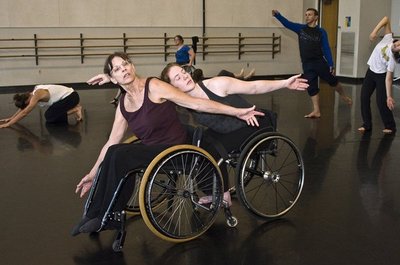August 19, 2010
Integrating dance: different bodies, different abilities
Twenty-two dancers converged on the UW Aug. 9-14, five of them in wheelchairs. The occasion was the Integrated Dance Summer Intensive, and the aim was to share processes whereby dance can be made more accessible to those with disabilities.
The intensive is organized by Jurg Koch, assistant professor of dance. He first created such an intensive in 2005, after which he attempted to bring integrated dance methods to his UW students in regular classes. But budget cuts have forced him to cut back on those activities, so the summer intensive returned last year and was repeated this year.
“Of the people who attended, 10 are professional dancers, including people who run integrated dance companies, educators and choreographers,” Koch said. “There were also eight people from the community and four student interns.”
Asked how many in the group were disabled, Koch declined to say. Although there were five wheelchair users, he said that others may have had hidden disabilities that they chose not to declare. “Let’s just say there was a spectrum of abilities, including different body types, ages and dance experiences,” he said.
Participants brought a variety of dance backgrounds, from ballet to ballroom, but all had some dance training, Koch said.
Morning sessions at the intensive opened with lectures and workshops led by the professional dancers and educators. Then Koch led a technique class in which he tried to teach not a particular way of dancing, but a way of teaching dance that makes it accessible to a wider group of dancers. He gave an example of the plie. This is a traditional move in ballet in which the dancer bends her knees outward and lowers the body, then rises again, while keeping the back straight.
“It’s done to build strength and control and to learn safe body alignment,” Koch said. “In integrated dance I don’t define how the movement is to be done. I tell the dancer to sink to the lowest point she’s capable of, then define a halfway point. I give the dancers a count — two to get to the intermediate point, two to the lowest point, four to recover, two to rise partway and two to return to the starting position. The dancers do it in accordance with their movement range.”
Similarly, he’ll ask each dancer to take an action starting with a reach, then full extension, then a turn, a suspension and a drop. Each dancer performs these movements according to his or her ability. Often, Koch will have the dancers work as partners, each doing their movements to the same count.
“There is no form that is called integrated dance,” Koch said. “But there is a field called integrated dance, and what we are trying to do is develop a methodology that gives access to dance to people who have a disability. Right now we have dancers with disabilities who have no way to get studio training, and we have dancers from integrated companies who are coming to the end of their active dancing careers and have no way to transition into higher education.”
Koch and his colleagues from the dance intensive will be working on making that possible.

